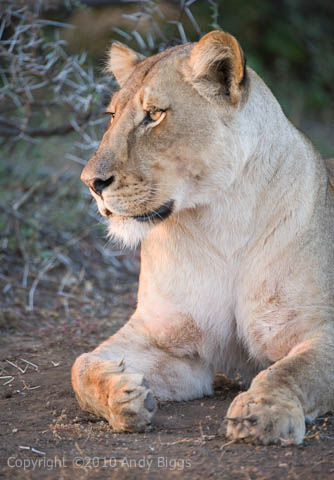Photo of the Day - Elephant Family at Savuti
 Thursday, August 25, 2011 at 10:00AM
Thursday, August 25, 2011 at 10:00AM
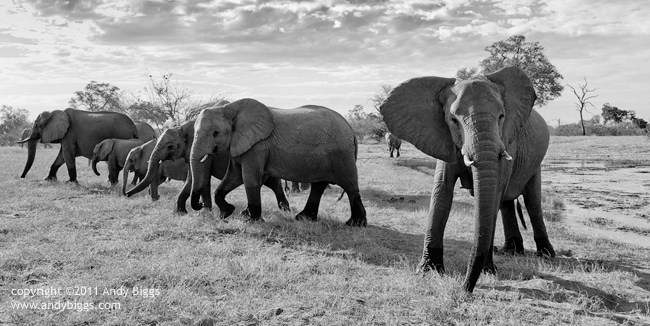
Elephant Family
near Savuti Camp, Botswana. July 2011
Nikon D3x, 28-300mm f/3.5-5.6, 1/320 sec @ f/9, ISO 400
I am an avid adventurer, conservationist, teacher, and outdoor photographer whose photography celebrates the African landscape and its rich wildlife, people, and culture. My photographic safaris allow my travelers to not only enhance their understanding of photography, lighting, and wildlife, but to develop a life-long admiration for Africa ‘s beauty and culture.
Banana Republic recently used my photographs as the cornerstone of their Urban Safari campaign, and my images were seen in all 750 stores around the globe, as well as in their billboards, catalogs and annual report. I was also the winner of the BBC Wildlife Photographer of the Year in the ‘Wild Places’ category in 2008 and a highly commended in the ‘Creative Visions of Nature’ category in 2007.
I launched Gura Gear in 2008, in an attempt to deliver lightweight camera bags to the market. I was looking for a lightweight camera bag to hold all of my photographic gear, and there was nothing desirable on the market that suited my needs. After spending 2 years with many prototypes, the Gura Gear Kiboko bag was born. More products are now available on the Gura Gear web site.
 Thursday, August 25, 2011 at 10:00AM
Thursday, August 25, 2011 at 10:00AM

Elephant Family
near Savuti Camp, Botswana. July 2011
Nikon D3x, 28-300mm f/3.5-5.6, 1/320 sec @ f/9, ISO 400
 Sunday, August 21, 2011 at 09:22PM
Sunday, August 21, 2011 at 09:22PM Dear Andy-
Well, we have sadly come to terms with the fact that the trip has come and gone. We are still pouring through hundreds of images and trying to complete a trip journal so as not to forget any of the fantastic experiences we had.
We had such a wonderful time on the safari. Part of it was certainly the wonder of Botswana and our first experience in Africa and on a safari. But a huge part of it was the expertise with which the trip was planned, down to the very finest details. Your expertise combined with that of James and Grant ensured not only an amazing experience “in country” but also enabled us to return with so many wonderful images! The trip was designed to provide maximum photographic opportunities and it delivered on its promise. There was a constant supply of not-to-be-missed chances to capture a special image.
Reflecting on the experience as a whole, it is pretty amazing to take a group of thirteen people, all strangers (well except for the couples!), fly them around in little planes to dirt airstrips, immerse them in a place with no contact with the outside world, ride them around for hours at a time in open vehicles over what can barely be called roads, and have them love it…yeah, pretty amazing.
Seriously, all the planning that goes into these trips is clearly reflected in the superb level of the accommodations, the delicious meals, the transportation (between and in the camps), the camp staff; all of it. Everything was top-notch and no detail was overlooked.
We so enjoyed the trip that the “once-in-a-lifetime” tag line can no longer be used. It is true that once you go to Africa, you feel you must return.
Lou & Terry
July 2011
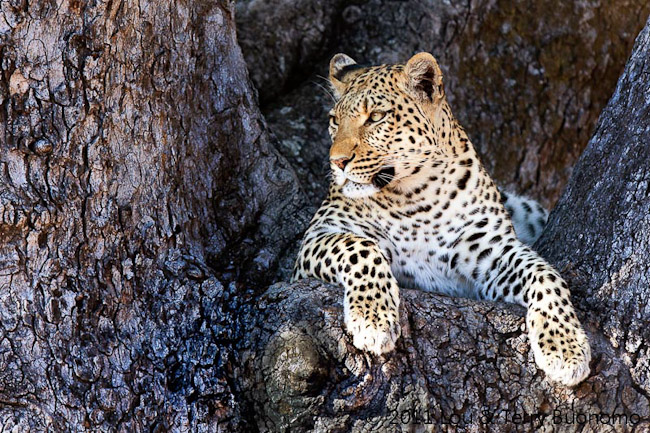

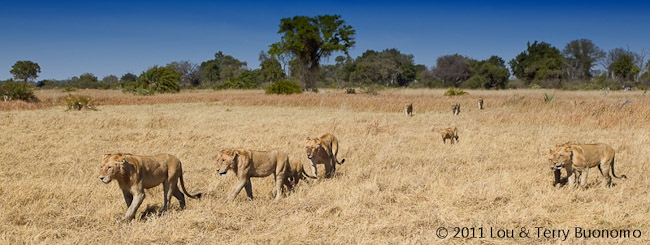
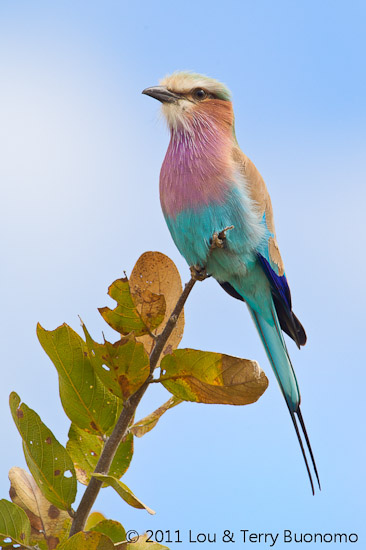

 Botswana,
Botswana,  Testimonial,
Testimonial,  africa in
africa in  Testimonials
Testimonials  Tuesday, August 16, 2011 at 11:27AM
Tuesday, August 16, 2011 at 11:27AM

Lioness Crossing Water
near Chitabe Camp, Okavango Delta, Botswana. July 2011
Nikon D3x, 200-400mm f/4 @ 340mm, 1/1250 @ f/4
I have been back from safari for a few weeks now, however I haven’t had much of a chance to process or even look at any of my images. I have had a few business related trips, as well as a well needed family vacation.
I absolutely love it when we find predators near and in water. The Okavango Delta in northern Botswana is a very dynamic place to photograph, as the water levels rise and fall throughout the year. When the water rises, you end up with more and more isolated pieces of ground amongst the water. This can be a great thing for photographers, as all wildlife will eventually need to move through these waters. When photographing cats in water, I do like to pay attention to leg positioning as well as head direction. Let’s paint a picture here. We watched a pride of lions on an unsuccessful hunt of impala, and after the imapal ran off through the water we anticipated the lions following one of the impalas that appeared to be hurt. We drove and then positioned the Land Rover so that we would shoot the lions coming through the water from a 90 degree angle, if not a slightly less than 90 degree angle. Why? Well, I supposed we could have shot them coming towards the vehicle, which is also a great shot, but the distance between us and the lions would have given them enough room to walk away from us. Wildlife rarely walks towards you, so rather than fight for an oncoming shot we went for a side shot. I like 90 or near-90 degree angles, because I do like to see at least 1 eye of my subject. For argument’s sake let’s just say that the angle here is 90 degrees. This allowed us to photograph the lioness with 1 eye showing and a hint of her 2nd eye. Eyes make all the difference in a wildlife image, as well as things like leg position and tail. Here we have a visible tail and 4 legs that seem to have a nice balance to them. If you zoom in closely on the image you can also see a nice splash in the water, which is an added ‘golden nugget’ that I like to look out for. Golden nuggest are just those things that help keep a viewer’s attention on an image.
From a processing standpoint, I processed the image in Lightroom with basic tweaks, and then finished the image off in Nik Software’s Viveza 2. One thing to note is that I actually desaturated the lion, as a lion can pick up a heavy orange/yellow color cast if you aren’t careful. The landscape portion of the image needed punch and more saturation, however the main subject did not.
 Friday, April 29, 2011 at 03:28PM
Friday, April 29, 2011 at 03:28PM
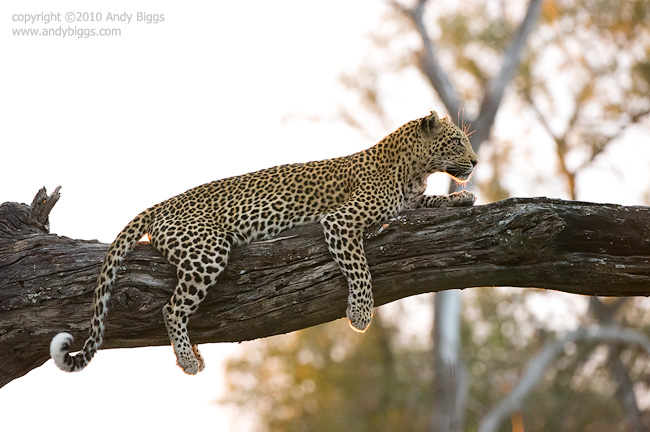
Leopard
Chitabe Camp, Okavango Delta, Botswana.
Nikon D700, 200-400mm, 1/200 @ f/5.6, ISO 6400
I do prefer dramatic lighting wherever I can find it, and if I can get a golden rim light on my subject I am going to race towards it. In this example, I waited and waited and waited for her to have a golden rim light on her chin, and the added bonus was the light on her right paw. I have about 30 shots of her prior to this one, but the sun was behind clouds for the earlier shots. This shot required a high ISO of 6400, and even then I was only able to get 1/200 of a second for my shutter speed. My exposure compensation for matrix metering was +1 2/3, as the only thing that matters in this scene is the leopard, and not the blown out sky.
I am leading more and more safaris to Botswana in 2012 (will be a total of 4), and I should have more safaris listed very soon.
 Botswana,
Botswana,  Chitabe,
Chitabe,  Leopard,
Leopard,  okavango in
okavango in  Photo of the Day
Photo of the Day  Thursday, April 28, 2011 at 12:41PM
Thursday, April 28, 2011 at 12:41PM
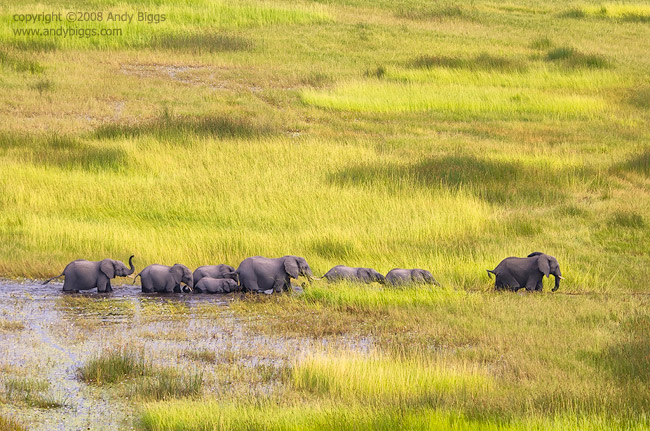
Elephant Family
Okavango Delta, Botswana
Canon 1DMk3, 100-400mm, 1/1250 @ f/5.6, ISO 400
Here is an image that was taken from a helicopter over the Okavango Delta, Botswana. I love to shoot aerial photographs, especially in and around the Okavango. I often take my safari travelers up in the air, as we are able to take off the doors of the helicopter and shoot away. I try and keep my minimum shutter speed at around 1/1000, as slower speeds start show some blur. Shooting wide open isn’t a big deal, because the subjects are far enough away where depth of field isn’t a concern at all. I have to make certain that my harness in the helicopter is extremely tight and won’t come loose, as it would be a loooong way down!
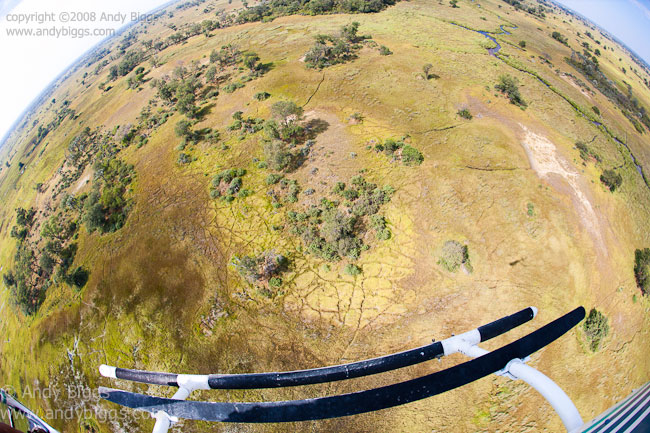
Here is a quick view with a 15mm fisheye, looking down from my shooting position.
 Botswana,
Botswana,  Elephant,
Elephant,  Helicopter,
Helicopter,  okavango in
okavango in  Photo of the Day
Photo of the Day  Friday, February 18, 2011 at 01:34PM
Friday, February 18, 2011 at 01:34PM
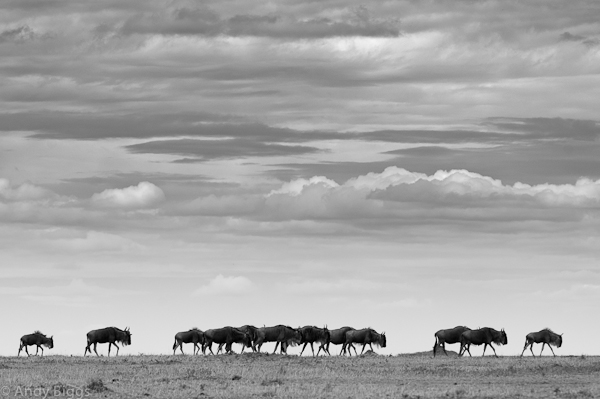
I do have a few more spots available for the rest of my 2011 safaris, as well as a few new safari announcements. If you are planning your 2011 schedule, and have been thinking about photographing some of the most amazing and abundant wildlife on the planet, here is a quick rundown of what I have available for the rest of the year.
Botswana: The Premier Wildlife Safari. July 4-13, 2011. Only 1 spot available.
Predators of the Sabi Sands, South Africa. July 25 - August 3, 2011. A few spots available, and limited to a max of 7 travelers.
Ultimate Mountain Gorillas and the Masai Mara. September 3-15, 2011. Only 2 spots available.
Kenya’s Masai Mara and Wildebeest River Crossings. September 14-23, 2011. New Announcement, limited to 7 travelers. Only a few spots available after only a couple of hours.
As you can see, my safaris do book up well in advance as there are only a few spots left on some of these safaris. The safaris that are already sold out are not contained in this blog post, and you can see my entire safari and workshop schedule on my main web site:
Andy Biggs Photo Safaris - Safaris and Workshop Schedule
I am starting to work on my 2012 safari and workshop schedule, and I will being to post the schedule as I start to get pricing and schedules all nailed down. It takes a ton of time to plan these safaris. I do know that I will be running two safaris in Botswana in September 2012, and Greg du Toit will be running the popular Predators of the Sabi Sands safari as well (July or August).
 Monday, December 6, 2010 at 03:43PM
Monday, December 6, 2010 at 03:43PM I use many different safari outfitters throughout Africa, as well as other providers that help me in different areas of my business, and one of the most reliable organizations I work with is Wilderness Safaris. Their camps are always top notch, and their professionalism both at the camps and in the home office always exceeds expectations. It is no surprise that Mombo Camp and Little Mombo Camp in Botswana’s Okavango Delta are yet again the Number 1 Resort in Africa in the 2010 Condé Nast Traveler (USA) Readers’ Choice Awards.
Aside from Mombo’s chart-topping achievement, a number of other Wilderness Safaris camps were prominent in the Top Resorts in Africa: Other camps in Botswana that were rated highly by readers of the magazine were the Okavango camps of Jao Camp (at eighth place) and Vumbura Plains, and the Linyanti camps of DumaTau and Savuti. Namibian camps that featured in Top African Resorts included the Kulala and Ongava camps at Sossusvlei and Etosha respectively.
Destinations were rated on the following criteria: Activities/facilities, food/dining, location, overall design, rooms, and service - all of which Mombo performed almost perfectly according to the readers of Condé Nast! As the magazine states: “Africa at its finest, this camp on the edge of a floodplain has a perfect-scoring location so exquisite, a movie set couldn’t replicate it.”
Most of the camps listed above are camps that I visit on my photographic safaris with my customers. I always frequent properties that me and my business look good, and a huge congratulations goes out to my friends at Wilderness Safaris for this very exciting award. You guys deserve it.
 Thursday, August 12, 2010 at 11:48PM
Thursday, August 12, 2010 at 11:48PM This morning’s game drive was mostly filled with trying to focus on the more elusive subjects, such as red-billed quelea, eland and kudu. On the surface these subjects seem quite easy to photograph, however it is quite difficult to get unique and creative photos of them. My attempts didn’t really work, but good photographs with unique behavior takes time.
I often see safari vehicles passing by subjects that can yield excellent images, and all too often these vehicles move along in search of big cats. Heck, I love leopards, lions and cheetahs just like anybody else, however looking over plains game, birds and everything in between is a huge mistake. Another huge mistake is to be impatient at a sighting and wanting to move on. Good photographs are created, not captured by doing quick drive-by type shooting. One needs to take the time to capture images that stir the soul, and that is the biggest secret that will help any nature photographer.
After our mid-day lecture and critique session, we headed out of camp towards the river system that flows through Mashatu. As we arrived at the river, we immediately noticed a large elephant herd filling up their bellies with fresh water. Cha-ching! Each member of the herd made its way down towards the water, and after finishing you could see the happiness in all of them as they played and sparred along the water’s edge. We didn’t need to move the vehicle for a while, and just enjoyed watching all of the fun going on down below. We positioned the vehicle on a ridge above the river, which had a great view of the action down below.
When the light started to fade, we worked some of the open fields in search of paw prints, and we located a single female lioness within a few minutes. She was out on her own, and the light was fading quickly when we located her. As like most lions in the daytime, she was lying down and napping. As the setting sun went over a hill, we were able to at least grab a few shots of the warm light on her face. I absolutely love the last minutes of light in the day, which can be very warm and direct. This warm light is something that I always try to use to my advantage, however it isn’t always there when I need it, or I don’t have a good subject to photograph in the warm light.
Note: All images in these daily blog postings are very very rough edits of the things we have seen, and I often omit the photographs that take too much time to process. I don’t take much time off during the day, as I am working with people with their photographic needs. All of my images in these posts will have to be re-processed when I get back home, and they are only included in these blog entries for illustration purposes.
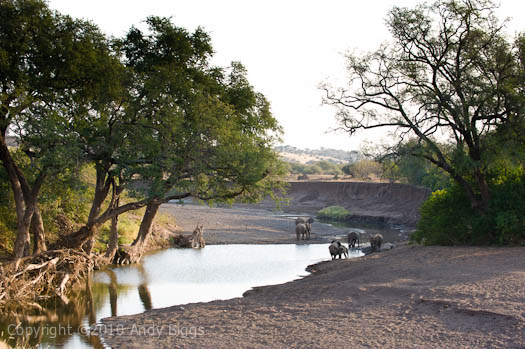
Our overlook for the elephants, before they arrived en masse

A more closeup view when the elephants arrived

Elephants drinking in the river
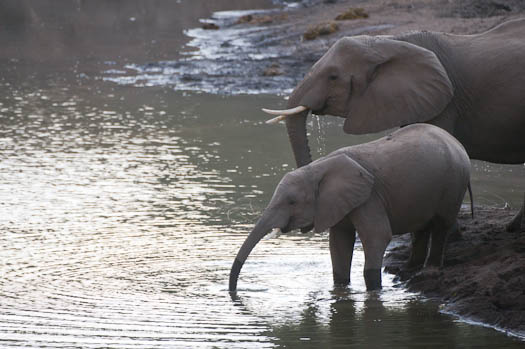
Elephants drinking in the river

Elephants drinking in the river

